Signal Encoding & Decoding
Oral
Acquisition, Reconstruction & Analysis
Tuesday, 19 June 2018
| N03 |
08:15 - 10:15 |
Moderators: Daniel Gallichan, Jana Hutter |
08:15
 |
0378.
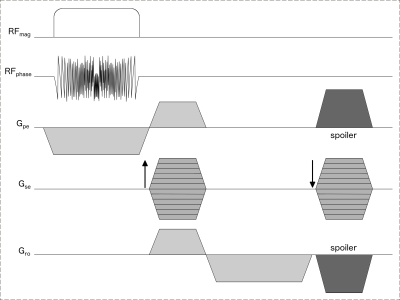 |
 Chirp-Encoded 3D GRE and MPRAGE sequences Chirp-Encoded 3D GRE and MPRAGE sequences
Kamlesh Pawar, Zhaolin Chen, Jingxin Zhang, N Shah, Gary Egan
Non-Fourier encoding such as random, noiselets and chirp encoding have demonstrated image quality improvement in accelerated compressive sensing (CS) MRI applications. However, implementation of the non-Fourier encoding schemes in 2D spin echo sequence limits its use in practice, due to the fact that spin echo is inherently a slow sequence. In this work, we present a novel implementation of chirp encoding in fast 3D gradient echo (GRE) and MPRAGE sequences. The chirp encoding scheme is compared with conventional Fourier encoding for compressive sensing and susceptibility weighted imaging applications. The evaluation demonstrates that chirp encoding is able to preserve spatial resolution better than the Fourier encoding.
|
08:27
|
0379.
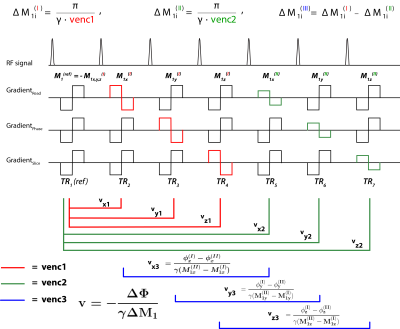 |
 Three Vencs for the Price of Two: Efficient Multi-Venc Phase-Contrast MRI for Improved Velocity Dynamic Range Three Vencs for the Price of Two: Efficient Multi-Venc Phase-Contrast MRI for Improved Velocity Dynamic Range
Liliana Ma, Kelvin Chow, Can Wu, Alireza Vali, Michael Markl, Susanne Schnell
Single-venc 4D flow MRI is inherently limited by the need to set a velocity encoding sensitivity (venc), where velocity(v)>venc results in velocity aliasing and v<<venc results in elevated noise. Thus, we propose a novel multi-venc encoding scheme for reconstruction of a triple-venc 4D flow dataset from our previously described 7TR dual-venc sequence. This triple-venc dataset can be used to improve velocity unwrapping without increasing scan time. The aim of this study was to systematically evaluate the utility of 7TR triple-venc velocity encoding to improve velocity dynamic range and further decrease velocity noise beyond the capabilities of current dual-venc methods.
|
08:39
|
0380.
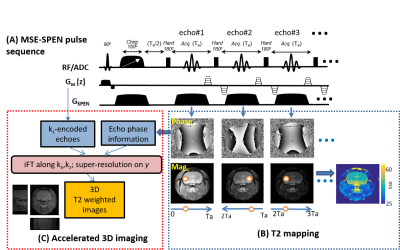 |
 Single-scan multi-spin-echo SPEN for dynamic T2 mapping and for 3D T2 weighted anatomical imaging Single-scan multi-spin-echo SPEN for dynamic T2 mapping and for 3D T2 weighted anatomical imaging
Qingjia Bao, Eddy Solomon, Gilad Liberman, Samuel Cousin, Lucio Fydman
SPatiotemporal ENcoding (SPEN) provides single-shot 2D images free from T2* effects, and with enhanced robustness to field distortions. SPEN’s acquisition module is relatively short, opening the possibility to combine SPEN with a multi-spin-echo protocol, thus collecting several images in one shot. This work explores this possibility towards two different aims: the single-shot characterization of spatially-resolved T2 maps, and the accelerated acquisition of 3D images incorporating a phase encoding. Both approaches proved successful, as exemplified with real-time T2 mapping of in vivo kidney on a perfused mouse and high resolution volumetric acquisitions on ex vivo phantoms and human volunteers.
|
08:51
|
0381.
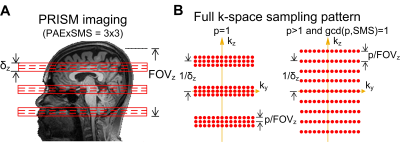 |
 Fast imaging with ultrahigh isotropic resolution using partition-encoded simultaneous multi-slab (PRISM) Fast imaging with ultrahigh isotropic resolution using partition-encoded simultaneous multi-slab (PRISM)
Wei-Tang Chang, Weili Lin
Fast imaging with ultrahigh isotropic resolution has gained widespread interests but is technically challenging. The simultaneous multi-slice (SMS) and 3D imaging can hardly achieve high isotropic resolution without compromising temporal resolution or imaging contrast that needs long TR. A novel method, Partition-encoded Simultaneous Multi-slab (PRISM) imaging, was proposed to mitigate the physical constraints of thin slice excitation by applying partition encoding onto simultaneous multi-slab acquisition and provide ultrahigh isotropic resolution while maintaining the acceleration capability and TR flexibility. Using the PRISM technique, whole-brain fMRI with spatial resolution of 1mm isotropic and a temporal resolution of 2 seconds has been achieved.
|
09:03
|
0382.
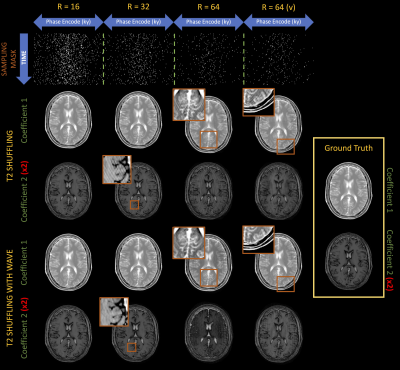 |
 Faster T2 Shuffling with Wave-encoding Faster T2 Shuffling with Wave-encoding
Siddharth Iyer, Berkin Bilgic, Kawin Setsompop
T2-shuffling is a recently proposed approach that can reconstruct multiple, sharp T2-weighted images from a single fast spin-echo (FSE) scan. Wave-CAIPI is a parallel imaging technique that uses additional sinusoidal gradients to spread aliasing in the readout direction, to take full advantage of coil-sensitivity information in highly accelerated rectilinear acquisitions. In this work, we augment T2-shuffling with wave-encoding and examine the ability of this combined approach in accelerating FSE acquisition that can achieve multiple T2-weighted images reconstruction. We demonstrate the efficacy of our technique through a 2D simulation, where wave-encoding was shown to provide good reconstruction at 2-3x higher accelerations.
|
09:15
|
0383.
 |
 Highspeed Imaging with Sub-millisecond Temporal Resolution of the Vocal Folds Oscillations using EGG-Gated Gradient Echo with Rapid Phase Encoding Highspeed Imaging with Sub-millisecond Temporal Resolution of the Vocal Folds Oscillations using EGG-Gated Gradient Echo with Rapid Phase Encoding
Johannes Fischer, Timo Abels, Ali Özen, Matthias Echternach, Bernhard Richter, Michael Bock
We present a novel encoding method that allows sampling of one-dimensional periodic motion with sub-millisecond time resolution by applying very short phase encoding gradients along the direction of motion. The technique is applied to the oscillatory motion of the vocal folds during singing, and MR data are gated using an electroglottography synchronisation signal. Dynamic images during vocal fold oscillation were acquired with a temporal resolution of about 690 µs, and closing of the vocal folds was assessed.
|
09:27
|
0384.
 |
 Synthetic MP2RAGE: multiple ‘on-demand’ contrasts from a single acquisition Synthetic MP2RAGE: multiple ‘on-demand’ contrasts from a single acquisition
Aurélien Massire, Thomas Troalen, Olivier Girard, Tobias Kober, Bénédicte Maréchal, Maxime Guye, Jean-Philippe Ranjeva, Virginie Callot
MP2RAGE and FLAWS sequences are increasingly used for brain clinical research imaging at ultra-high field. Yet, the ability to provide at the same time an optimal contrast between GM and WM for segmentation, an accurate T1 mapping and/or the ability to highlight only a single tissue or lesions, is in practice not possible with only one single MP2RAGE acquisition. In this work, we demonstrate that synthetic ‘uniform’ images with ‘on-demand’ clinically relevant contrasts could be generated at 7T from a single MP2RAGE acquisition providing an accurate T1 map, allowing for instance tissue signal nulling or lesion signal enhancement.
|
09:39
 |
0385.
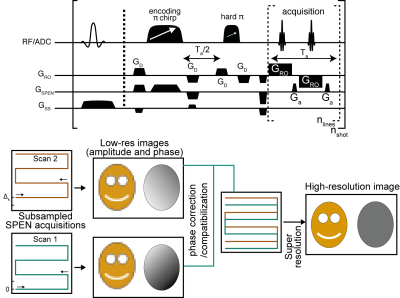 |
 Interleaved SPEN with per-shot correction for high definition human DTI measurements Interleaved SPEN with per-shot correction for high definition human DTI measurements
Samuel Cousin, Gilad Liberman, Eddy Solomon, Lucio Frydman
Sub-mm DTI is of great interest for clinical diagnosis and healthy tissue studies. Segmented imaging is hindered in these applications, due to complications associated to unavoidable motions in-between shots. This work demonstrates the advantages resulting from using interleaved, segmented SPatially ENcoded (SPEN) methods for DTI, thanks to their ability to (i) provide low-resolution but fully sampled images per shot; (ii) compensate for rigid-body motions by simple phase corrections, and (iii) zoom on restricted FOVs without folding complications. All this enables high-resolution diffusion MRI on humans, as shown here by delineating the pons anatomy at a 0.74mm in-plane resolution.
|
09:51
|
0386.
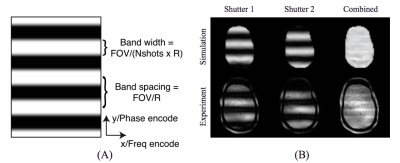 |
 Parallel Transmit Excitation Pulses for Shuttered Echo Planar Imaging Parallel Transmit Excitation Pulses for Shuttered Echo Planar Imaging
Zhipeng Cao, Xinqiang Yan, William Grissom
A parallel transmission based shutter excitation is proposed for multishot EPI that overcomes its sensitivity to motion and dynamic phase changes between shots. The g-factor performance, flip angle error, and SAR are characterized as a function of the number of transmit coils, and compared to ideal single-channel excitation.
|
10:03
|
0387.
 |
 An Optimized 3D Stack-of-Stars TSE Pulse Sequence for Simultaneous T2-weighted Imaging and T2 Mapping An Optimized 3D Stack-of-Stars TSE Pulse Sequence for Simultaneous T2-weighted Imaging and T2 Mapping
Mahesh Bharath Keerthivasan, Kevin Johnson, Manojkumar Saranathan, Craig Weinkauf, Diego Martin, Ali Bilgin, Maria Altbach
A 3D stack-of-stars Turbo Spin Echo sequence is presented for efficient T2-weighted imaging and T2 mapping. The pulse sequence parameters are optimized for T2 estimation, SNR, and SAR and the view ordering is designed to enable efficient k-space coverage for both non-selective and slab selective acquisitions. The technique provides excellent anatomical coverage within clinically acceptable times. Utility of the sequence is demonstrated in vivo on the knee, brain and for carotid vessel wall imaging.
|
|












